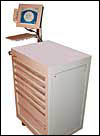Pittsburgh-based Mobile Aspects, a supplier of RFID-based tracking systems in hospitals, has released a new collection of RFID hardware and software products called One System of Care. It merges three new asset- and patient-tracking products with Mobile Aspects’ Intelligent Radio-Frequency Inventory System (iRIS), an RFID-enabled, modular inventory-management system that enables the tracking of critical, consumable supplies in places such as operating rooms and catheter labs, where procedures involving cardiac catherization take place (see Healthy RFID Rivalry for Hospitals).
The Web-based One System of Care software filters the data collected by the Mobile Aspects hardware, according to a rules engine maintained by the system administrator, and accesses the hospital’s existing information management systems, such as billing, electronic medical records, and patient admission/discharge/transfer systems. The One System of Care software is based on Health Level 7 (HL7), a data-exchange protocol that is a standard in the healthcare industry. “HL7 is basically a glorified XML,” says Suneil Mandava, president and CEO of Mobile Aspects.
Each hospital employee has a profile in the One System of Care user database that determines which databases or patient information the employee can access. Each employee also has a password-protected personal Web page to use as a work calendar-scheduling tool and message center. Department heads within the hospitals work with the system administrator to determine what kinds of scheduling, patient or inventory information and alerts to post on employee sites. For example, a surgical nurse could refer to his or her page for a schedule of surgeries, a list of patients and their locations in the hospital, and alerts on shortages of various hospital supplies.
The One System of Care is now available after successful beta testing in an undisclosed hospital. Mandava says the development of One System of Care was driven largely by requests made by hospital staff that had been using various Mobile Aspects products. He says the decision to make the One System of Care software Web-based came from doctors and nurses saying they wanted to access information on patients and assets from any computer—even one at their home.
The three new products included in the system are the Patient Tracking System, the Drug Delivery and Anesthesia Workstation, and the Asset Tracking System. All of the products are linked together through the One System of Care software. Passive 13.56 MHz tags and readers are used in all of the system components, ensuring interoperability. Mobile Aspects’ Mandava says the company uses high-frequency products because they do not cause interference with hospital equipment, which is generally operated in the ultra-high-frequency band. “We’re exploring ultra-wideband,” says Mandava, “though I think that’s still in its infancy. But we are always open to new technologies.”
The Patient Tracking System uses fixed readers located through the hospital and Mobile Aspects’ tags embedded into patients’ wristbands that transmit a unique ID, correlating with patient information in a database. This allows real-time tracking of each patient in a monitored area.
The Drug Delivery and Anesthesia Workstation prevents drugs from being inappropriately administered. It is portable cabinet with drawers containing RFID-tagged drugs. Wireless, fixed readers inside the workstation constantly monitor the drawers’ contents. When a nurse, anesthesiologist or other employee logs in to the workstation by waving an RFID-enabled badge or swiping a magnetic-stripe badge, the system grants access to the attached keyboard and touch-screen monitor and the drawers containing the drugs automatically unlock.
Integrated with the Patient Tracking System, the Drug Delivery and Anesthesia Workstation calls up pertinent information regarding the patient to whom the drugs are being administered. Because it is linked to the hospital’s physician order-entry system, where doctors enter drug prescriptions, the workstation alert a user if he or she removes the wrong drug or one that will cause a drug reaction or allergy in the patient, or if the physician’s prescription conflicts with another drug the patient is already receiving. The workstation also updates the patient’s electronic medical record with all drugs and supplies administered.
With the Asset Tracking System, hospital staff can keep track of nonconsumable, high-value portable items, such a tagged wheelchairs, as they move through the surgical suites and areas that contain Mobile Aspects’ HF readers. It can be programmed to send an alert when equipment leaves the facility without appropriate approval. The Patient Tracking System can also be programmed to alert hospital personnel if a patient leaves a designated area.


